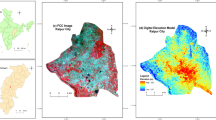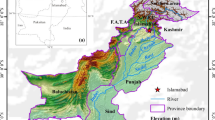Abstract
This paper, using a revised Penman-Monteith model, computed the terrestrial surface humidity index of the Loess Plateau (China) based on climatic factors of monthly mean temperature, maximum temperature, minimum temperature, relative humidity, precipitation, wind speed and sunshine duration observed on the plateau from 1961 to 2008. The temporal-spatial distribution, anomaly distribution and sub-regional temporal variations of the terrestrial surface dry and wet conditions were analyzed as well. The results showed a decreasing trend in the annual average surface humidity from the southeast to the northwest in the research area. Over the period of 1961–2008, an aridification tendency appeared sharply in the central interior region of the Loess Plateau, and less sharply in the middle part of the region. The border region showed the weakest tendency of aridification. It is clear that aridification diffused in all directions from the interior region. The spatial anomaly distribution of the terrestrial surface dry and wet conditions on the Loess Plateau can be divided into three key areas: the southern, western and eastern regions. The terrestrial annual humidity index displayed a significantly descending trend and showed remarkable abrupt changes from wet to dry in the years 1967, 1977 and 1979. In the above mentioned three key areas for dry and wet conditions, the terrestrial annual humidity index exhibited a fluctuation period of 3–4 years, while in the southern region, a fluctuation period of 7–8 years existed at the same time.
Similar content being viewed by others
References
Allen R G, Pereira L S, Raes D, et al. 1998. Crop evapotranspiration: guidelines for computing crop water requirements. FAO Irrigation and Drainage Paper 56. Rome: FAO.
Chattopadhyay N, Hulme M. 1997. Evaporation and potential evapotranspiration in India under conditions of recent and future climate change. Agricultural and Forest Meteorology, 87: 55–73.
Chen S B, Liu Y F, Axel Thomas. 2006. Climatic change on the Tibetan Plateau: potential evapotranspiration trends from 1961–2000. Climatic Change, 76: 291–319.
Ci L J, Yang X H, Chen Z X. 2002. The potential impacts of climate change scenarios on desertification in China. Earth Science Frontiers, 9(2): 287–294.
Deng G Y. 1979. A climatic calculative method of evaporation from open water. Acta Meteorologica Sinica, 37(3): 87–96.
Ding Y G, Shi N. 1992. Research on convergence of the eigenvalues for the EOFs expansion of meteorological field among different schemes. Chinese Journal of Atmospheric Sciences, 16(4): 436–443.
Du J, Li C, La B, et al. 2009. Climatic changes of terrestrial surface humid index and its impact factors over Tibet in recent 35 years. Acta Meteorologica Sinica, 67(1): 158–164.
Guo R, Li F M, He W Y, et al. 2011. Spatial and temporal variability of annual precipitation during 1958–2007 in Loess Plateau, China. In: IFIP. Advances in Information and Communication Technology, 345: 551–560.
IPCC. 2007. Climate Change 2007: Impacts, Adaptation and Vulnerability. In: Parry M L, Canziani O F, Palutikof J P, et al. Contribution of Working Group II to the Fourth Assessment Report of the Intergovernmental Panel on Climate Change. Cambridge and Newyork: Cambridge University Press.
IPCC. 2012. Summary for Policymakers. In: Field C B, Barros V, Stocker T F, et al. Managing the Risks of Extreme Events and Disasters to Advance Climate Change Adaptation. A Special Report of Working Groups I and II of the Intergovernmental Panel on Climate Change. Cambridge and New York: Cambridge University Press, 1–19.
Jesen M E, Burman R D, Allen R G. 1990. Evapotranspiration and irrigation water requirements. In: Jensen M E, Burman R D, Allen RG. ASCE Manuals and Reports on Engineering Practice No. 70. New York: American Society of Civil Engineer, 80–112.
Jiang D B, Su M F, Wei R Q, et al. 2009. Variation and projection of drought and wet conditions in Xinjiang. Chinese Journal of Atmospheric Sciences, 33(1): 90–98.
Kendall M G. 1975. Rank Correlation Methods. London: Griffin.
Li H X, Liu G H, Fu B J. 2012. Estimation of regional evapotranspiration in alpine area and its response to land use change: a case study in Three-River Headwaters region of Qinghai-Tibet Plateau, China. Chinese Geographical Science, 22(4): 437–449.
Liu Q, Yang Z F, Cui B S. 2008. Spatial and temporal variability of annual precipitation during 1961–2006 in Yellow River Basin, China. Journal of Hydrology, 361: 330–338.
Liu W Q, Wang F T. 2002. Analysis on vulnerability of agro-production to climate change in the Loess Plateau. Journal of Nanjing Institute of Meteorology, 25(5): 620–624.
Lu A G. 2009. Spatial and temporal precipitation variation on the Loess Plateau in the past half century. Ecology and Environmental Sciences, 18(3): 957–959.
Ma Z G, Fu C B. 2001. Trend of surface humid index in the arid area of northern China. Acta Meteorologica Sinica, 59(6): 737–746.
Ma Z G, Fu C B. 2005. Decadal variations of arid and semi-arid boundary in China. Chinese Journal of Geophysics, 48(3): 519–525.
Ma Z G. 2005. Dry/wet variation and its relationship with regional warming in arid-regions of northern China. Chinese Journal of Geophysics, 48(5): 1011–1018.
Mann H B. 1945. Nonparametric tests against trend. Econometrica, 13: 245–259.
Mitchell J M, Dzerdzeevskii B, Flohn H, et al. 1966. Climate change. In: WMO Technical Note No. 79. Geneva: World Meteorological Organization.
Shen S H, Zhang F M, Sheng Q. 2009. Spatio-temporal changes of wetness index in China from 1975 to 2004. Transactions of the CSAE, 25(1): 11–15.
Thomas A. 2000. Spatial and temporal characteristics of potential evapotranspiration trends over China. International Journal of Climatology, 20: 381–396.
Walter I A, Allen R G, Elliott R, et al. 2000. ASCE’s standardized reference evapotranspiration equation. In: Evans R G, Benham B L, Trooien T P. Proceedings of the National Irrigation Symposium, ASAE. Phoenix: ASCE, 1–6.
Wang P X, Yang J H. 2007. Extreme high temperature events and response to regional warming in recent 45 years in northwest China. Journal of Desert Research, 27(4): 649–654.
Wang Y Q, Fan J, Shao M A, et al. 2008a. Analysis of effects of climate change on reference evapotranspiration on the Loess Plateau in recent 50 years. Transactions of the CSAE, 24(9): 6–10.
Wang W, Chen X, Shi P, et al. 2008b. Detecting changes in extreme precipitation and extreme streamflow in the Dongjiang River Basin in southern China. Hydrology and Earth System Science, 12: 207–221.
Wang Y R, Yin X Z, Yuan Z P. 2004. Main characteristics of climate system in Loess Plateau in China. Journal of Catastrophology, 19(z1): 40–47.
Wei F Y. 2007. Statistic Diagnose and Foreshadow Technology in Present Climate. Beijing: Meteorological Press, 115–131.
Wu H B, Wu L. 2005. Methods for Diagnosing and Forecasting Climate Variability. Beijing: Meteorological Press, 208–244.
Wu S H, Yin Y H, Zheng D, et al. 2005. Study of dry and wet state in recent 30 years in China. Science in China: Series D, 35(3): 276–283.
Xie X Q, Wang L. 2007. Changes of potential evaporation in northern China over the past 50 years. Journal of Natural Resources, 22(5): 684–690.
Yao Y B, Wang Y R, Li Y H, et al. 2005. Climate warming and drying and its environmental effects in the Loess Plateau. Resources Science, 27(5): 146–152.
Yao Y B, Yang J H, Yue P, et al. 2011a. Climatic change of terrestrial surface humid index and its impact factors over the source region of three rivers in recent 50 years. Ecology and Environmental Sciences, 20(11): 1585–1593.
Yao Y B, Wang R Y, Yang J H, et al. 2011b. Change of terrestrial surface potential evapotranspiration in Loess Plateau. Ecology and Environmental Sciences, 20(8–9): 1189–1195.
Zhang J Y, Dong W J, Fu C B, et al. 2003. The influence of vegetation cover on summer precipitation in China: a statistical analysis of NDVI and climate data. Advances in Atmospheric Sciences, 20(6): 1002–1006.
Zhang Q, Liu C L, Xu C Y, et al. 2006. Observed trends of annual maximum water level and streamflow during past 130 years in the Yangtze River basin, China. Journal of hydrology, 324: 255–265.
Zhang Q, Deng Z Y, Zhao Y D, et al. 2008. The impacts of global climatic change on the agriculture in northwest China. Acta Ecologica Sinica, 28(3): 1210–1218.
Zhang Q, Sun Z X, Wang S. 2011. Analysis of variation regularity of land-surface physical quantities over Dingxi region of the Loess Plateau. Chinese Journal of Geophysics, 54(7): 1727–1731.
Zhao Y X, Wang F T, Liu W Q. 2003. Climatic ecological environment, climate change and agricultural productivity in Loess P1ateau. Agricultural Research in the Arid Areas, 21(4): 142–147.
Zhou L S. 2000. China’s Agro-geography. Beijing: Science Press, 347–364.
Zuo D K, Wang Y X, Chen J S. 1993. Spatial Distribution Characters of Solar Radiation in China. In: Zuo D K. Geographical Research Paper. Beijing: Science Press, 168–185.
Author information
Authors and Affiliations
Corresponding author
Rights and permissions
About this article
Cite this article
Yao, Y., Wang, R., Yang, J. et al. Changes in terrestrial surface dry and wet conditions on the Loess Plateau (China) during the last half century. J. Arid Land 5, 15–24 (2013). https://doi.org/10.1007/s40333-013-0137-3
Received:
Revised:
Accepted:
Published:
Issue Date:
DOI: https://doi.org/10.1007/s40333-013-0137-3




